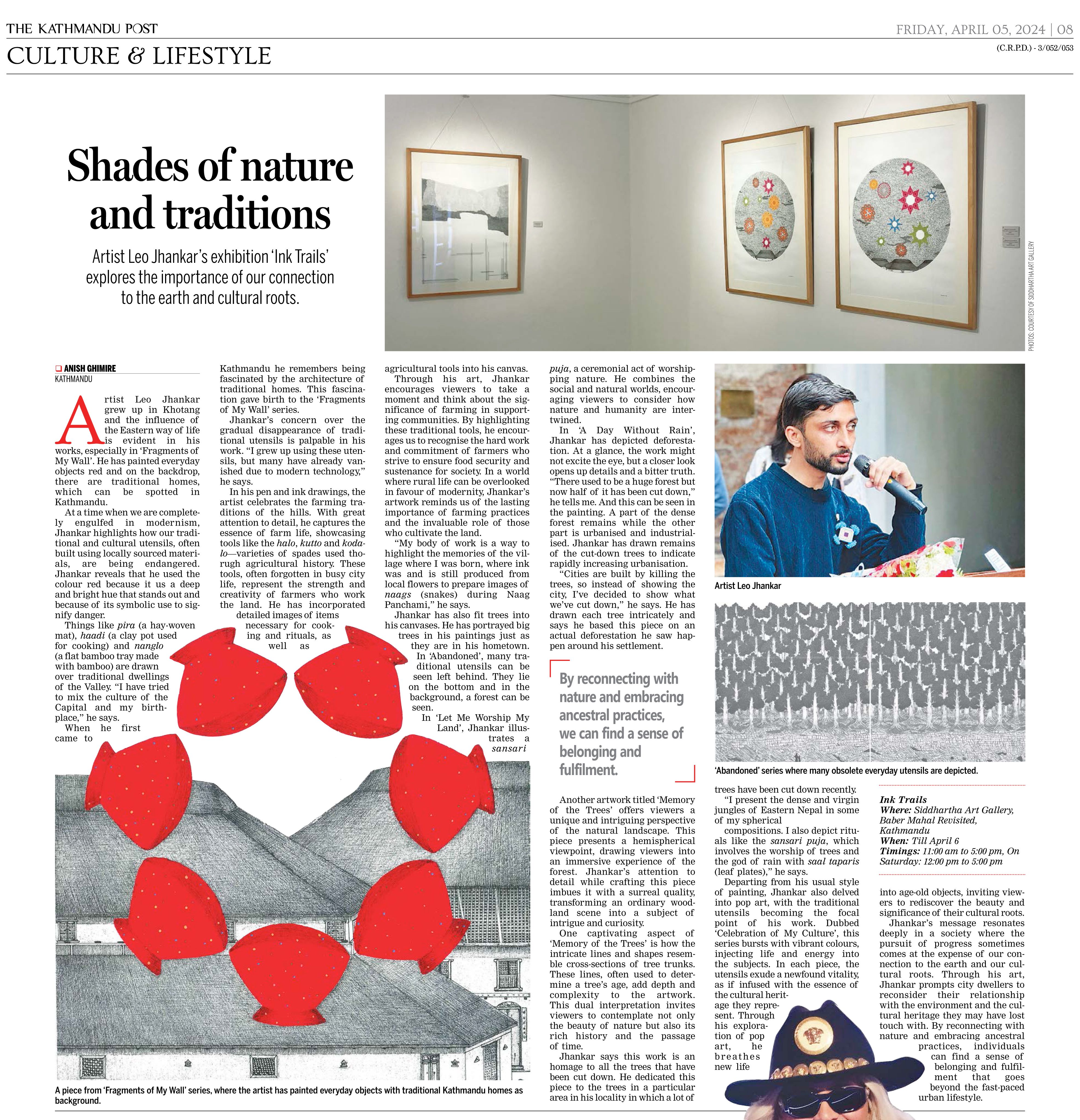Ink Trails

WHEN: March 17 - April 06, 2024
WHERE: Siddhartha Art Gallery
Gallery Statement
Leo Jhankar’s first solo exhibition presents delicate portrayals of the natural and cultural elements of the Eastern hills of Nepal. His drawings are enveloped by the dense and luscious wilderness of the region as the trees coil together in uniformity and stretch towards the ever-expanding sky.
Beyond capturing the beauty of the landscape, Jhankar also peers into the cultural fabric of the countryside. He delves into the idea of material memory—even the most mundane objects used by people have a sense of history to them with respect to how they were used and by whom. Everyday objects, often built using locally sourced materials, like the pira (a mat woven with hay), haadi (a clay pot used for cooking), and nanglo (a flat woven bamboo tray), are featured distinctively in his drawings, alluding to their functional and aesthetic significance. In pieces such as ‘Fragments on my Wall,’ Jhankar juxtaposes these objects against the backdrop of traditional dwellings, inviting reflection on the erosion of traditional practices in the face of mass production.
His pen & ink drawings pay homage to the agrarian tradition in the hills. Tools like halo, kutto, kodalo (varied forms of spades) serve as symbols for farming traditions which are often overlooked in urban settings. Jhankar prompts viewers to acknowledge the vital role of farmers in sustaining and nourishing communities.
The artwork ‘Memory of the Trees’ provides a lowered, hemispherical perspective of the landscape. Jhankar achieved this effect with much labour and attention to detail, which gives this image of an otherwise ordinary forest a surreal effect. It is also interesting to note that these drawings also look like cross-sections of trunks—often used to determine a tree’s age.
There is rhythm and repetition in his works—which almost feel like measured breathing or meditation. At first glance, the prominently featured dense forests may seem like a continuation of natural motifs, but upon closer inspection, subtle differences in style and subject begin manifesting themselves. In ‘Let me worship my land’, Jhankar depicts a ‘Sansari Puja’ (a ritualistic practice to worship nature) between lush woods. He merges the natural with the societal, inviting viewers to contemplate the interconnectedness of man and nature.
In an era marked by urbanisation and detachment from traditional knowledge, Jhankar’s work serves as a poignant reminder of the value of living in harmony with nature and preserving one’s cultural practices. As city dwellers grapple with issues of alienation and isolation, his art encourages a reconnection to the rhythms of the natural world and the wisdom of ancestral practices.
Urza Acharya
Curatorial Assistant
Artist Statement
I use ink to create my art. This medium, which has been used for hundreds of years by writers, archivists, and artists, has become embedded in our DNA. While creating my artworks, I found inspiration and connection to the people who have used this medium in the past. My body of work is a way to highlight the memories of the village where I was born, where ink was and is still produced from local flowers to prepare ‘Naag’ images during Naag Panchami.
My works represent the beauty, narratives and challenges of the culture in which I grew up. I present the dense and virgin jungles of Eastern Nepal in some of my spherical compositions. I also depict rituals like the ‘Sansari Puja’, which involves the worship of trees and the God of Rain with ‘Saal’ leaf ‘taparis.’ I incorporate detailed images of items necessary for cooking, rituals, as well as agricultural tools into my canvas. These tools have now become obsolete, whereas in the past, they were the very essence of what made village life so distinctive. I pay homage to traditional Nepali village houses and the unique ways in which wood, metal, mind and stone are used to craft mundane yet beautiful things.
My other drawings also portray similar narratives in varied compositions and celebrate the rich culture in Kathmandu.
Leo Jhankar
